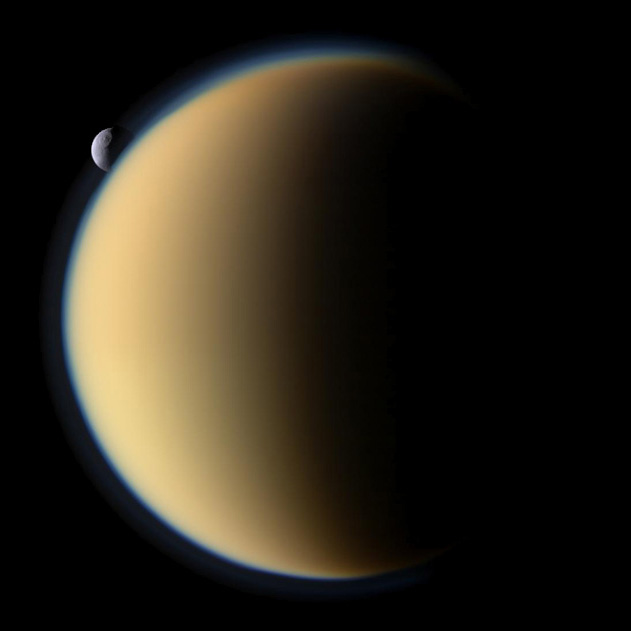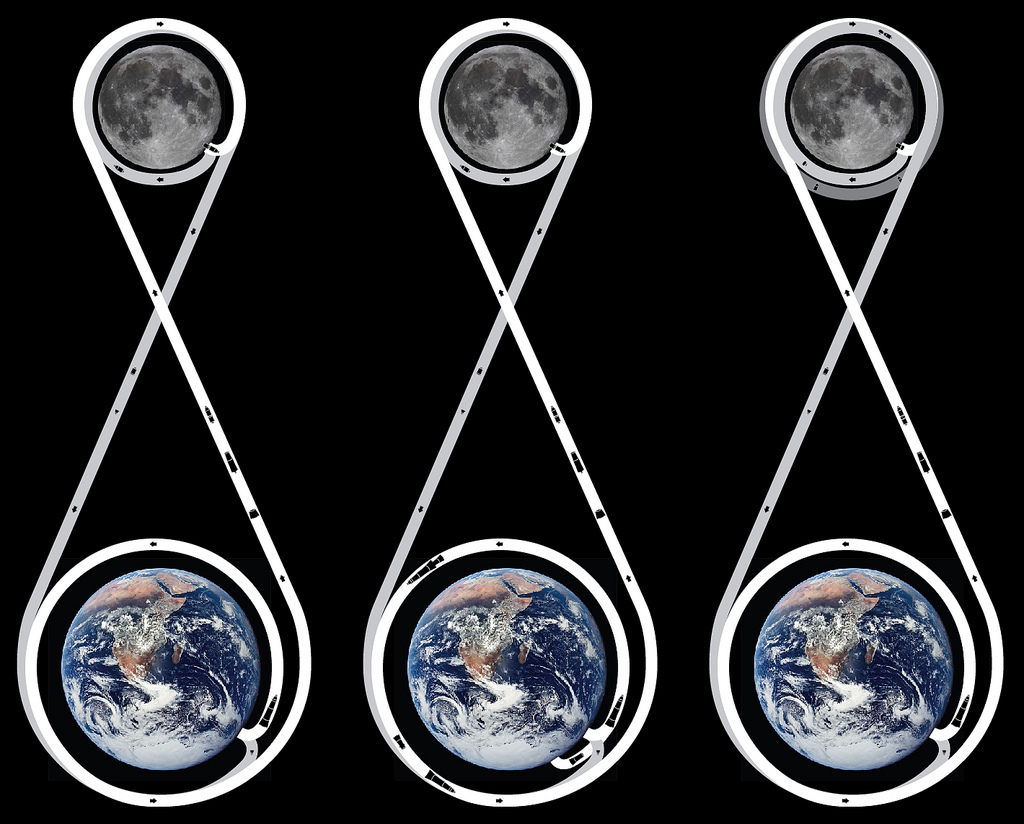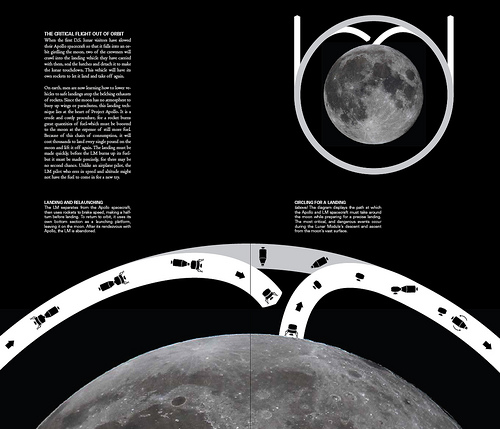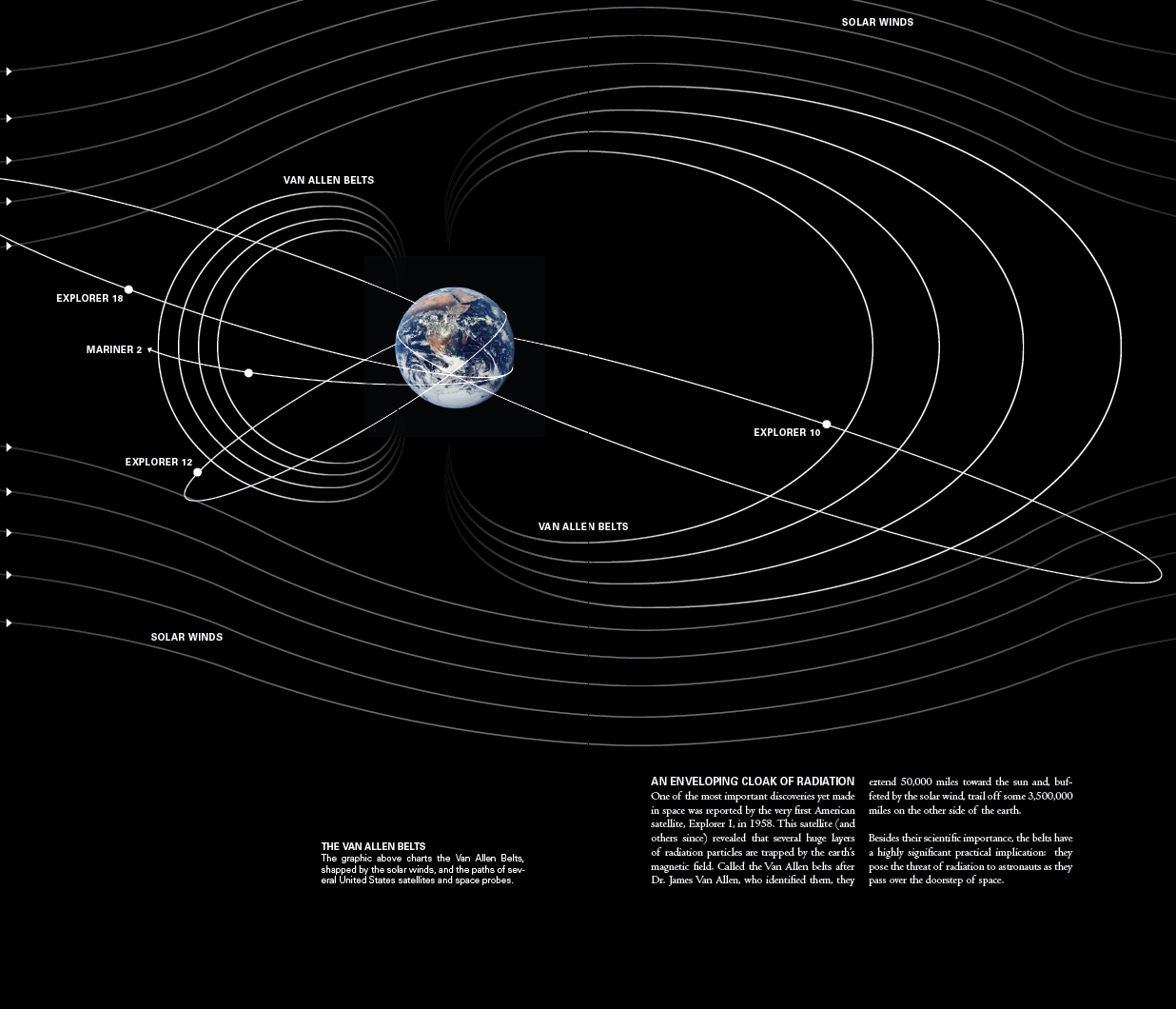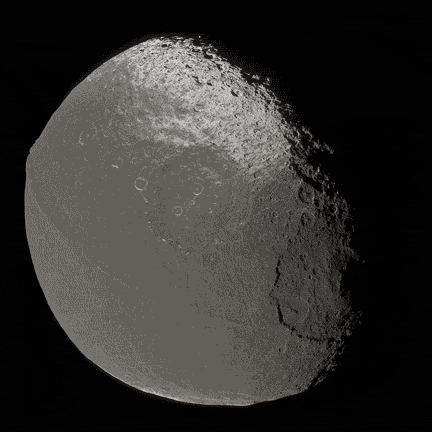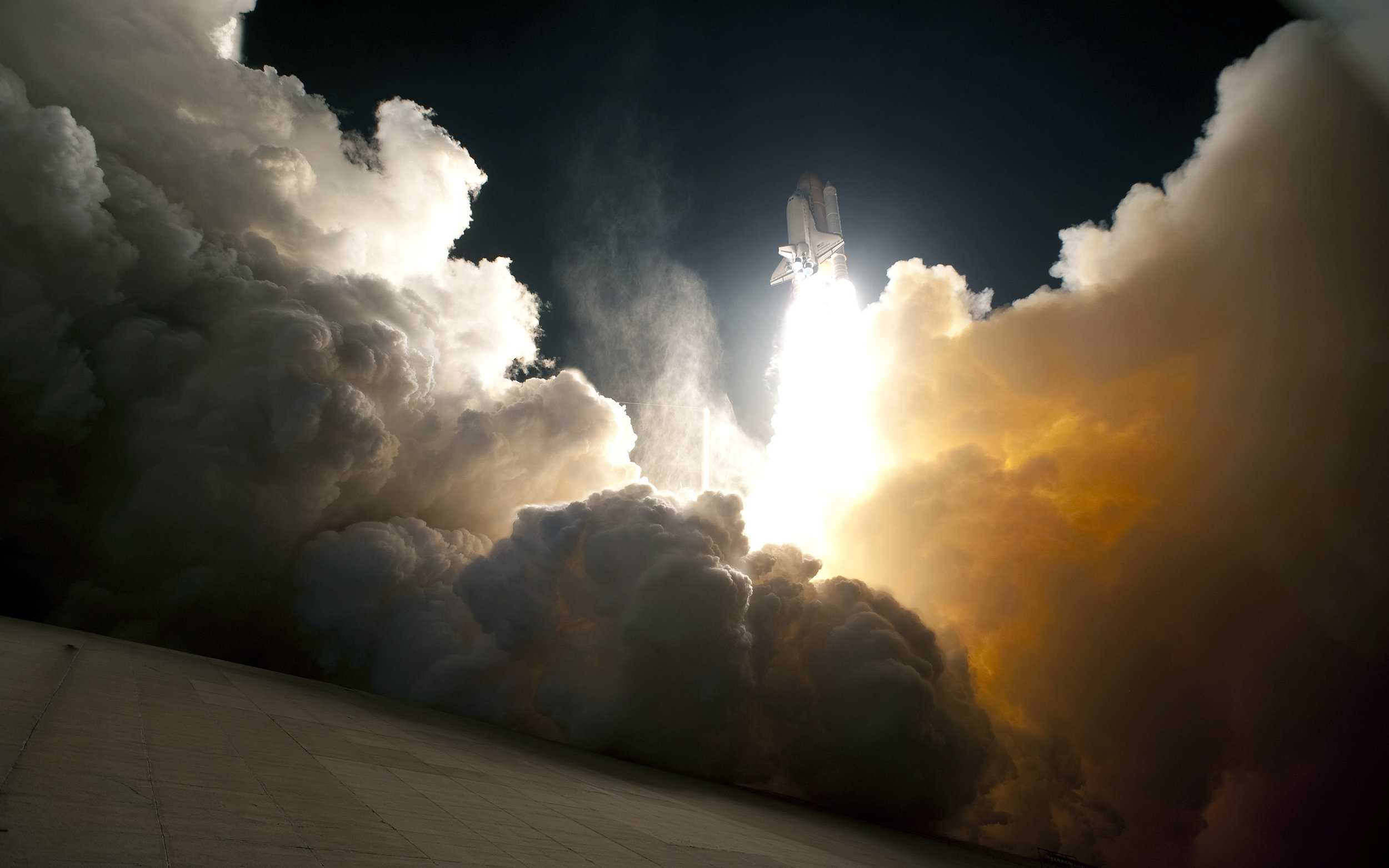If you think you have seen everything there is to see from The Space Shuttle… think again. Unless you are into the drama of suspense… Skip to around 2 minutes and watch the whole thing. It is incredible. Just a camera mounted to a solid rocket booster from launch to splash down. Seriously gorgeous. Things to watch out for is the separation and the other solid rocket burning out in the distance and the parachutes on splash down.
New Iconic Celebrates 23 Deep Space Missions & The Planetary Society
 Robotic and human missions of exploration that extended beyond the Earth’s orbit. 23 historic missions in total (with an additional 6 separations) that are recognized for their notable achievements to various celestial bodies in our solar system with targets including the Sun, planets and their moons, comets and asteroids. Nearly every icon represents a specific robotic explorer (or series) with the exception of the Apollo program which continues to be the single human endeavor to ever go beyond the cradle.
Robotic and human missions of exploration that extended beyond the Earth’s orbit. 23 historic missions in total (with an additional 6 separations) that are recognized for their notable achievements to various celestial bodies in our solar system with targets including the Sun, planets and their moons, comets and asteroids. Nearly every icon represents a specific robotic explorer (or series) with the exception of the Apollo program which continues to be the single human endeavor to ever go beyond the cradle.
If you buy a copy we will donate $5 of every purchase to The Planetary Society. The world’s largest space-interest group dedicated to inspiring the public with the adventure and mystery of space exploration. A non-governmental organization founded in 1980, who among its founders included Carl Sagan, the author of Cosmos.
If you buy a copywith a membership (sorry, US residents only), we will register you as a new member for only an additional $25 (normally $37). See here for what you get as a new member.
Robonaut
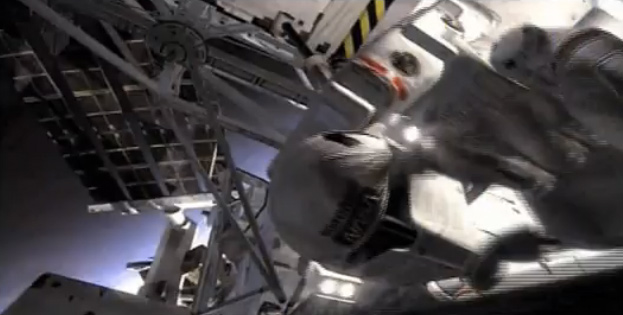 No, this is not Boba Fett in a deleted scene from a Star Wars movie. This is for real. NASA plans a “robonaut” on the Moon in 1000 days… from now!? NASA really doesn’t understand how to promote itself does it… How is this not bigger news?
No, this is not Boba Fett in a deleted scene from a Star Wars movie. This is for real. NASA plans a “robonaut” on the Moon in 1000 days… from now!? NASA really doesn’t understand how to promote itself does it… How is this not bigger news?
Space Exploration is a Good Idea
 In case readers of this blog are not aware, our main gig in life is running a design studio called Chopping Block and a (mostly) t-shirts shop called Chop Shop. In an effort to increase the amount of awesome design featuring space exploration, we have been posting the work of other artists here and now we have decided to officially join the ranks by releasing some of space related work of our very own starting with our A Good Idea tshirt.
In case readers of this blog are not aware, our main gig in life is running a design studio called Chopping Block and a (mostly) t-shirts shop called Chop Shop. In an effort to increase the amount of awesome design featuring space exploration, we have been posting the work of other artists here and now we have decided to officially join the ranks by releasing some of space related work of our very own starting with our A Good Idea tshirt.
Friend of the Chop, Matthew Borgatti, made this cosmonaut lamp a while back and it made it’s way around the web as clever things often do. We asked Matthew to convert it into a drawing so we could display his concept on chests the world over. The title is a play on a famous graphic design slogan, “design is a good idea”. Our point-of-view is that space exploration is a good idea as well.
By the way, yes… it does glow in the dark.
Vintage-Styled Soviet Space Posters
 Contained within Justinvg’s excellent poster set on flickr are these gorgeous posters celebrating early Soviet triumphs in space. There are 5 total; Sputnik, Sputnik 2, The Luna Program, Vostock and Voskhod. But if you are a fan of Star Wars — don’t miss his fictional travel poster series (which are also included in the same set as these Soviet ones).
Contained within Justinvg’s excellent poster set on flickr are these gorgeous posters celebrating early Soviet triumphs in space. There are 5 total; Sputnik, Sputnik 2, The Luna Program, Vostock and Voskhod. But if you are a fan of Star Wars — don’t miss his fictional travel poster series (which are also included in the same set as these Soviet ones).
Schenk’s House of 3-D Moons!
Paul Schenk has been taking new and old data from missions to the various moons of Jupiter, Saturn, Uranus and Neptune and building 3-D models of what it might be like to fly through some of their more fascinating features. These are renders built from actual images, so often you might see areas of lower resolution due to a lack of better mission data. The one posted above of Hi'iaka Montes on Io is one of the best on his youTube page as the data available from the region is mostly in high resolution with few gaps.
Sometimes Raw Images are Enough
Okay, Set Scene: Rings, Titan, Geysers…
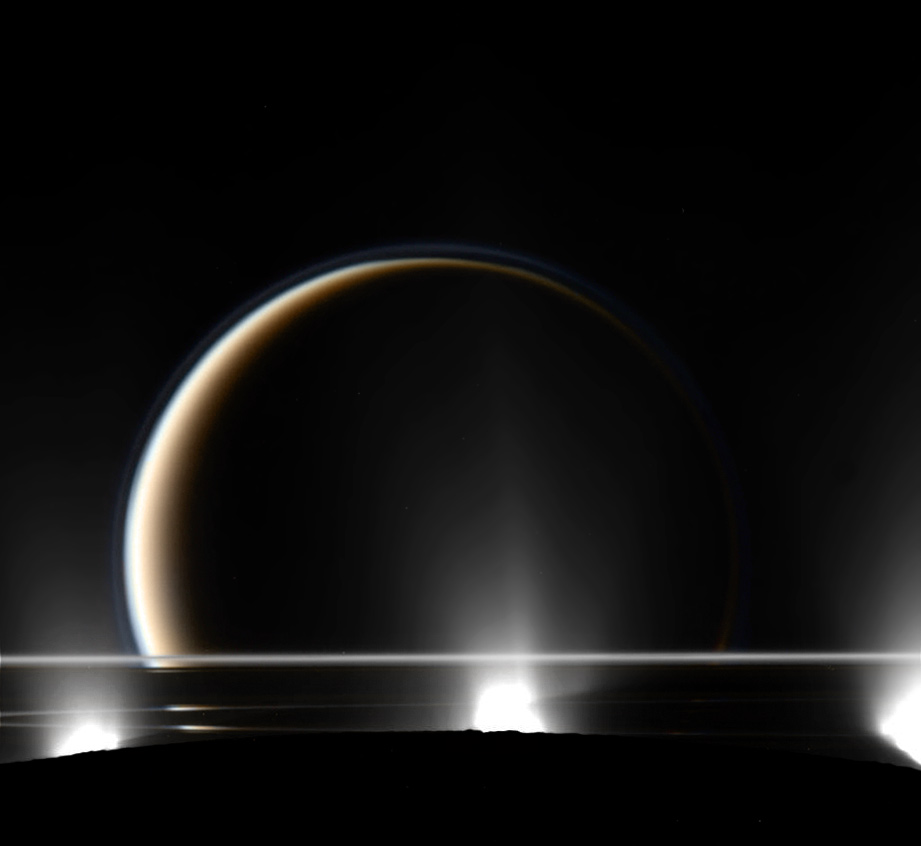 This composite has been kicked around a bunch on unmannedspaceflight.com. Contained within it are two separate images taken by the Cassini mission at nearly the same time but different exposures. Looking at this scene with human eyes, the big difference would likely be that the geysers would not be blown out and would look more like a multiple of gentle hazes spewing upward. The other big difference would be that you were somehow on a mission to Saturn and not browsing the web.
This composite has been kicked around a bunch on unmannedspaceflight.com. Contained within it are two separate images taken by the Cassini mission at nearly the same time but different exposures. Looking at this scene with human eyes, the big difference would likely be that the geysers would not be blown out and would look more like a multiple of gentle hazes spewing upward. The other big difference would be that you were somehow on a mission to Saturn and not browsing the web.
Above are the two original exposures. These were merely combined with a photo editing tool. The geyser haze was blurred in areas to clean out compression artifacts and the color was artistically added by Gordan Ugarkovic. While the color is artificially generated, it does accurately reflect the same overall appearance of most natural light images of Titan.
Hayabusa Delivers
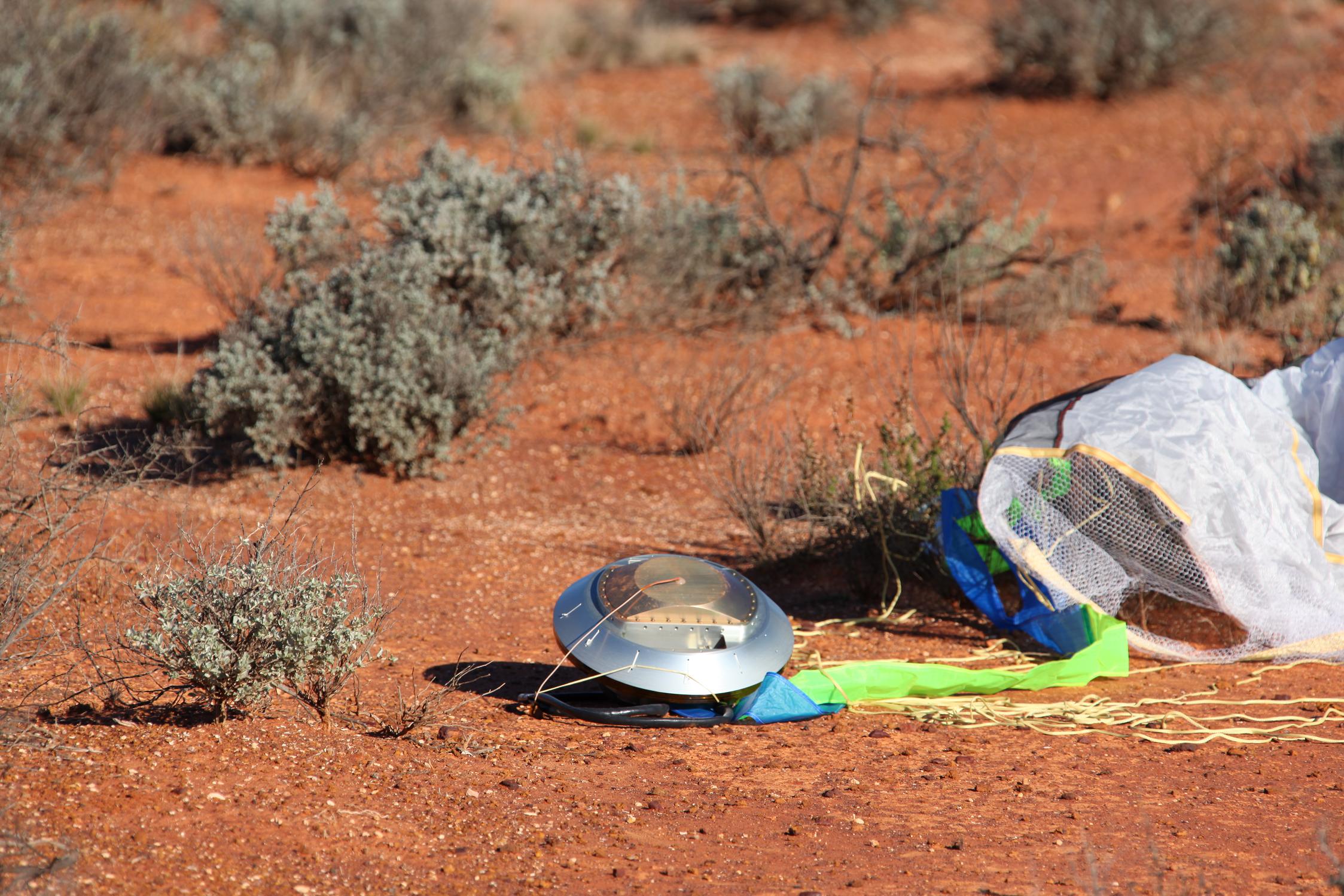 In contrast to nearly every other phase of the mission to and from Itokawa, the re-entry and landing on Earth went without a hitch. The capsule was retrieved and returned to Tokyo, where hopefully it will contain the first ever asteroid samples that did not go through the extreme heat of passing through the Earth atmosphere.
In contrast to nearly every other phase of the mission to and from Itokawa, the re-entry and landing on Earth went without a hitch. The capsule was retrieved and returned to Tokyo, where hopefully it will contain the first ever asteroid samples that did not go through the extreme heat of passing through the Earth atmosphere.
Saturn Still Images Come to Life
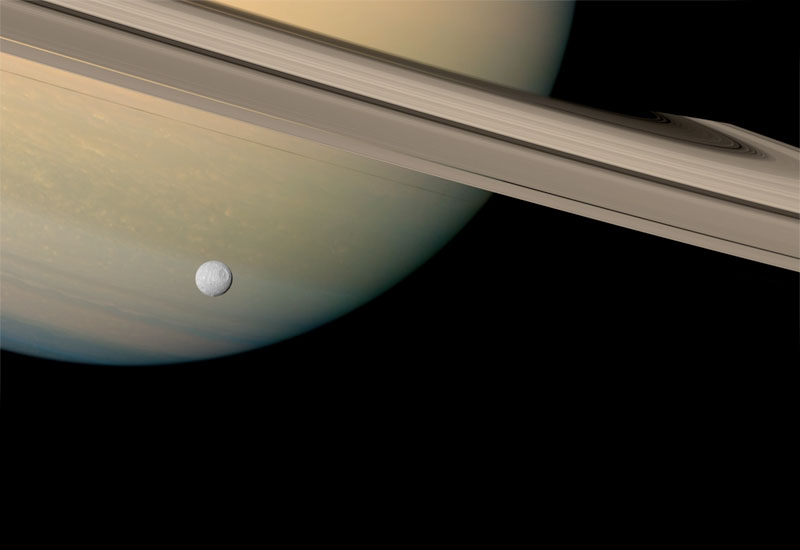 If you haven’t followed the work of Stephen v2 and his film “Outside In”, you might want to take a look at what he has in store for us. Using only still images from the Cassini mission, Stephen is making a very impressive tour of the Saturn system without using any CGI, 3D models or textures. While those techniques make great Hollywood films they often fall short of making something that is actually a real place… look real. See below for a very brief clip of how this all ends up looking with a much better and longer clip coming in the near future.
If you haven’t followed the work of Stephen v2 and his film “Outside In”, you might want to take a look at what he has in store for us. Using only still images from the Cassini mission, Stephen is making a very impressive tour of the Saturn system without using any CGI, 3D models or textures. While those techniques make great Hollywood films they often fall short of making something that is actually a real place… look real. See below for a very brief clip of how this all ends up looking with a much better and longer clip coming in the near future.
from New "Outside In" clip teaser from stephen v2 on Vimeo.
June: Hayabusa Comes Home?
 If you Google “Hayabusa” you will likely find a few articles about a mission plagued by problems and will leave you with the impression that the engineers at JAXA are a bunch of bumbling goons. What you will find less of is the fact that a sample-return mission is just about the most difficult types of missions any organization can attempt. As a matter of fact, only 4 sample-return missions (other than Apollo) have ever been successfully executed in history. Two Lunar missions by the Soviets with Luna 20 and 24 and much later, two American lead missions Genesis and Stardust which collected space dust and cometary particles. It is worth noting also that only two of those missions actually included landing on the surface of another body, grabbing some samples and then returning home. So for JAXA to even attempt such a bold mission without having even 1% the robotic mission experience of the USA and the Russians is all by itself an accomplishment.
If you Google “Hayabusa” you will likely find a few articles about a mission plagued by problems and will leave you with the impression that the engineers at JAXA are a bunch of bumbling goons. What you will find less of is the fact that a sample-return mission is just about the most difficult types of missions any organization can attempt. As a matter of fact, only 4 sample-return missions (other than Apollo) have ever been successfully executed in history. Two Lunar missions by the Soviets with Luna 20 and 24 and much later, two American lead missions Genesis and Stardust which collected space dust and cometary particles. It is worth noting also that only two of those missions actually included landing on the surface of another body, grabbing some samples and then returning home. So for JAXA to even attempt such a bold mission without having even 1% the robotic mission experience of the USA and the Russians is all by itself an accomplishment.
So what were the failures? Well, there is a long list of issues including: a Solar Flare that destroyed solar cells aboard the craft, two reaction wheels that control movement failed, two attempts to fire pellets at the surface failed (to kick up the samples into the collection cannister) and finally a whole litany of communication errors, fuel leaks and telemetry issues which put the mission in serious doubt of ever returning to Earth. To make a long story short — the probe did touch-down on the surface of asteroid Itokowa. The first such mission ever intentionally designed to do so (NASA did have an impromptu touch down on 433 Eros in 2000, but that was more a controlled crash). Despite the pellet failures, mission specialists think that the very act of touching down was likely to kick up enough dust to collect some materials in the collection canister. After much wrangling with a seriously debilitated spacecraft they managed to get Hayabusa on make-shift trajectory back to Earth, very much later than planned… but home just the same.
With fingers crossed, the sample package is to parachute down in South Australia on or around June 13th at which point it will be shuttled back to Japan and hopefully they will find something contained within. Even if it is just a few particles, it will still be the only samples of asteroid particles un-altered by the extreme heat of a natural Earth entry (aka: a meteor) and only the 3rd time in history a probe landed on another world and returned a piece of it back to Earth for study. Not bad for the new kids in space.
Pictured at top is a frame from the trailer “Hayabusa Back to Earth” in anticipation of the potentially successful sample-return mission. It appears to be a 3-D render based on actual images returned from the mission. The second is an actual image with the shadow of the spacecraft as it maneuvered to a close encounter with its target. The third image illustrates what touch-down may have been like for Hayabusa. You can see the large amount of theoretical dust kicked up by the thrusters which may be JAXA’s best hope for actually having captured particles in the sample-return canister.
Prometheus Looking Dramatic
 This is one of the tiny moons of Saturn seen up close around Jan 27, 2010 by Cassini. In case you do not recall, it is the moon responsible for some of the best ring disturbance movies of the mission.
This is one of the tiny moons of Saturn seen up close around Jan 27, 2010 by Cassini. In case you do not recall, it is the moon responsible for some of the best ring disturbance movies of the mission.
Tethys at the Edge of Titan
The Death Star Moon in Great Detail
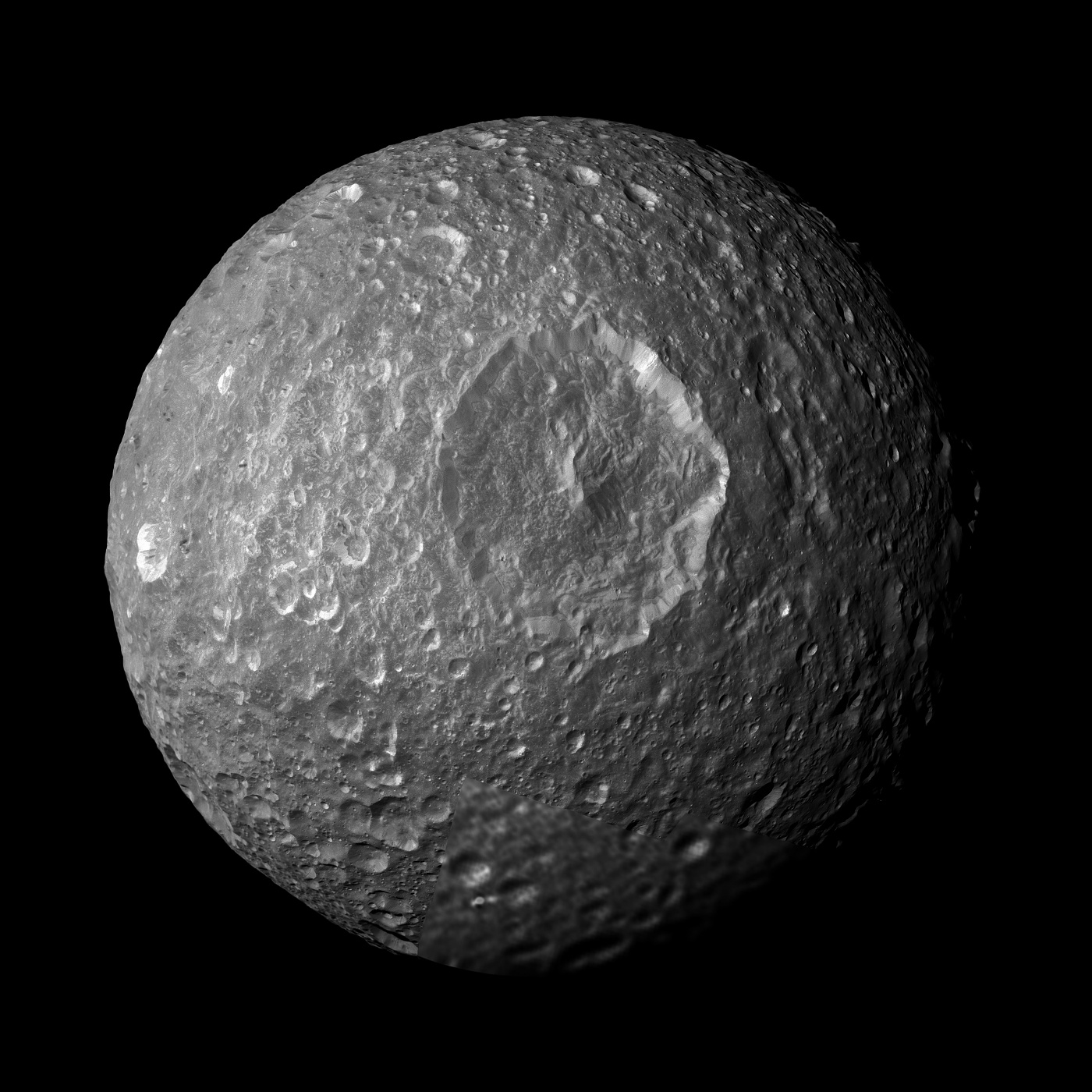 Commonly known by most as that “Death Star Moon” — Mimas, is seen here in the some of the finest detail ever (and seen here in sick detail). Flying to within 9,500 kilometers (5,900 miles) of the moon, Cassini captured the infamous Herschel Crater dead center in the still frame. Herschel, a feature which upon its originating impact, likely came close to shattering the tiny moon into another Saturnian ring.
Commonly known by most as that “Death Star Moon” — Mimas, is seen here in the some of the finest detail ever (and seen here in sick detail). Flying to within 9,500 kilometers (5,900 miles) of the moon, Cassini captured the infamous Herschel Crater dead center in the still frame. Herschel, a feature which upon its originating impact, likely came close to shattering the tiny moon into another Saturnian ring.
The image itself is a mosaic of several high-resolution images carefully placed together to make a full disc image. The lower right hand corner segment is (sadly) in a much lower resolution than the rest, but I’ll bet you didn’t even notice until I pointed it out and ruined it for you.
Eric Zelinski Redesigns Man and Space
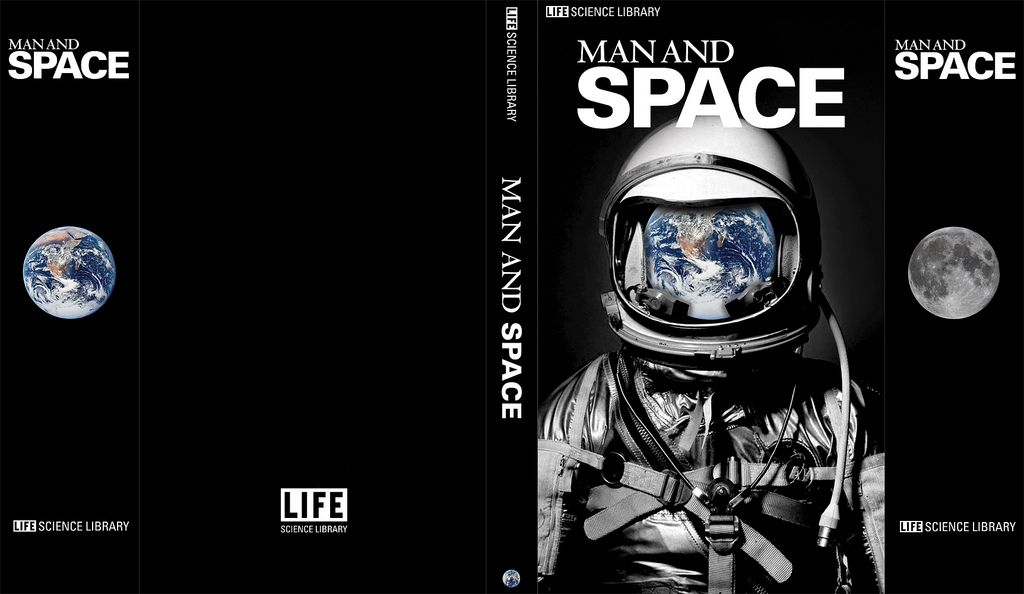 Eric Zelinski had an unusual inspiration to redesign 4 chapters of a classic educational book; Time Life Science Library's Man and Space. The edition was first printed in 1964 and contained some very basic info-graphics on various space travel themes of the era. Keep in mind that this is pre-Apollo — so some of the items were conceptually unproven, but based upon generally accepted models of that time.
Eric Zelinski had an unusual inspiration to redesign 4 chapters of a classic educational book; Time Life Science Library's Man and Space. The edition was first printed in 1964 and contained some very basic info-graphics on various space travel themes of the era. Keep in mind that this is pre-Apollo — so some of the items were conceptually unproven, but based upon generally accepted models of that time.
Seen above is “Ways to Go” which presents 3 different ways that NASA was actually considering for getting a man to the surface of the moon and back. Judging from the upstanding rockets seen in diagram #1 and #2, I think #3 is closer to the method that prevailed.
A diagram of the way back home.
A bit of more general information on the local environment around earth.
See also Eric’s submissions to the t-shirt giant Threadless. Many are space themed and his current submission is “Us Divided” which features a cosmic Earth split in two. It is now available for voting, so why not show some support?
Rounding the Pole of Iapetus
Shuttle in Colorful Bands of Atmosphere
 Text taken from spaceflight.nasa.gov: Though astronauts and cosmonauts often encounter striking scenes of Earth's limb, this very unique image, part of a series over Earth's colorful horizon, has the added feature of a silhouette of the space shuttle Endeavour. The image was photographed by an Expedition 22 crew member prior to STS-130 rendezvous and docking operations with the International Space Station. Docking occurred at 11:06 p.m. (CST) on Feb. 9, 2010. The orbital outpost was at 46.9 south latitude and 80.5 west longitude, over the South Pacific Ocean off the coast of southern Chile with an altitude of 183 nautical miles when the image was recorded. The orange layer is the troposphere, where all of the weather and clouds which we typically watch and experience are generated and contained. This orange layer gives way to the whitish Stratosphere and then into the Mesosphere. In some frames the black color is part of a window frame rather than the blackness of space.
Text taken from spaceflight.nasa.gov: Though astronauts and cosmonauts often encounter striking scenes of Earth's limb, this very unique image, part of a series over Earth's colorful horizon, has the added feature of a silhouette of the space shuttle Endeavour. The image was photographed by an Expedition 22 crew member prior to STS-130 rendezvous and docking operations with the International Space Station. Docking occurred at 11:06 p.m. (CST) on Feb. 9, 2010. The orbital outpost was at 46.9 south latitude and 80.5 west longitude, over the South Pacific Ocean off the coast of southern Chile with an altitude of 183 nautical miles when the image was recorded. The orange layer is the troposphere, where all of the weather and clouds which we typically watch and experience are generated and contained. This orange layer gives way to the whitish Stratosphere and then into the Mesosphere. In some frames the black color is part of a window frame rather than the blackness of space.
Best Launch Image Ever Taken
Just In Time For the Last
Nobody Expected Pluto to be This Active
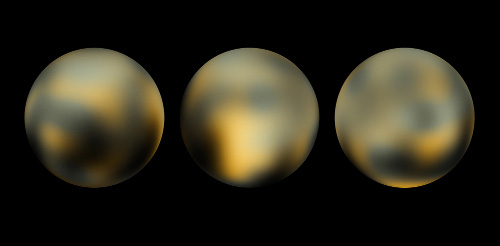 Recent Hubble images of Pluto are showing us a world that may be unexpectedly active on the surface. Such a small object so far away that takes so very long to revolve around the sun should not have very many ways to exercise such rapid changes upon its surface. Scientists studying Pluto say that the color shape shifting seen in just two years is shockingly dramatic and they know these changes are not some image artifact as Charon (Pluto’s dwarf planet partner) remains unchanged during the same period. Plainly, there is something happening on Pluto that is not taking place on another nearby body.
Recent Hubble images of Pluto are showing us a world that may be unexpectedly active on the surface. Such a small object so far away that takes so very long to revolve around the sun should not have very many ways to exercise such rapid changes upon its surface. Scientists studying Pluto say that the color shape shifting seen in just two years is shockingly dramatic and they know these changes are not some image artifact as Charon (Pluto’s dwarf planet partner) remains unchanged during the same period. Plainly, there is something happening on Pluto that is not taking place on another nearby body.
I expected the arrival of New Horizons at Pluto in 2015 to reveal to us another grey frozen cratered world, but instead… the encounter looks like it might be quite a bit more exciting than expected. I cannot wait to see this black, orange and active world up-close and hopefully New Horizons will also reveal to us what processes could possibly be causing such changes to take place. See Centauri Dreams for more.







